A slightly unusual post this week and next - a two part photoessay on the industrial suburbs of Tyneside, inspired by the photographs of Chris Killip. I hope you enjoy.
I owe Chris Killip. As a teenager, in the brilliant white of the Getty in Los Angeles, I first encountered two of his photography collections. In Flagrante and Seacoal. The images transfixed me.
I visited the collection twice, then bought a camera, and have aspired to be a photographer ever since.
Eight years later, I stood in front of another collection of Killip’s, this time in the Laing in Newcastle-upon-Tyne. The Last Ships recorded everyday life in the final years of Swan Hunter, the largest shipyard on a river famous for building ships.
My brother and I planned to walk the eight miles from the Laing along the river to the coast. It would take us through the former industrial heartlands of the city. Ouseburn, Byker and Wallsend out to North Shields and Tynemouth, passing on our way, what was once the mighty Swan Hunter.
J.B. Priestley made the same journey 90 years ago, albeit in a car. He knew the importance of the region even if few others did: ‘England would not be the England we know,’ he wrote, ‘if Tyneside were not the Tyneside we know.’
It was a sultry grey day. Drizzle came and went with no warning, sweating out of the low, heavy sky. We left the Laing and headed east through the edges of Newcastle’s centre, crossing the tangle of dual carriageways that wrap its eastern side. Then we turned down towards the river, to Ouseburn.
Ouseburn was busy that day, even if the weather wasn’t much. The renovated warehouses huddled tightly in the valley of the tributary. Glassy fronts and coffee shops. Families pottered. Kids with ice cream clung to the painted railing that runs along the stream. It was pleasant.
For most of Ouseburn’s life, it was the opposite.
It was here, far enough downstream from the town proper, that the city’s most polluting workshops were found. Tanneries and dye works, chemical plants, paintworks and factories. There were potteries and brickyards. Steam-powered flax mills made sail cloth for the ships. Lead works synthesised toxic white paint. Its poisoned workers developed blue lines around their gums. Many became colic, blind or partially paralysed.
Just beside the stream, livestock would be led down the steep hill to the slaughterhouses, their leather to the tanneries, then boots and ships. Their bones were crushed for manure. Their blood was left to congeal and then mixed with oil to create blue paint. The smell was rancid and unbearable, mingling with the piles of manure dumped near the glassworks.
Fortunately, that kind of industry has long since leached away. Renovation came in the early 2000s. Many old buildings were demolished, replaced by cheerful artistic places and cool bars. It’s the arty area now. The Shoreditch of Newcastle. The lead works were covered in sterile earth to become the Ouseburn Farm. The Biscuit Factory houses seven floors of artists.
Evidence of art is all over the area, from the bold, colourful street paintings to the quirky boats that sit half beached on the banks of the stream. In 2022, Timeout named it one of the ‘coolest neighbourhoods’ in the UK.
We reach the Tyne. It looked moody in the drizzle. It meandered and we followed the embankment up to the Free Trade Inn. Its name was no doubt a dig at Maggie Thatcher. In truth Thatcher had little direct impact on Ouseburn. Its workshops were already mostly abandoned by her time. But she did have an impact indirectly.
I met a man while hitchhiking a couple of years ago. He had been an old school raver, recovered at last. He told me about the raves that rippled through Ouseburn in the ‘90s. How they gave creative expression to a disenfranchised youth left nothing by the departing Thatcher.
They broke into old paintworks and flax mills and filled the decrepit rooms with smoke, lasers and music that lasted for days. The music was dark and heavy, reflective of the mood and the situation. The drugs by contrast were clean and happy, psychedelics and MDMA. People felt together. My friend told me about a rave the police shut down, how people had gone wading across the Ouse to avoid the riot shields.
The raves petered out in the 2000s as Ouseburn gentrified. For my mate, the raving lingered. He continued for 20 more years. All over the country. Eventually, his drug addiction became too severe. He finally gave up crack in his 50s. He didn’t regret it, though. Those moments in Ouseburn he’d never forget.
The great bridges of Newcastle are perhaps the city’s most visceral feature. You can look ahead at the curving facades, shops and life as usual, but glance upwards and you’ll see, far above the chimneys, their fierce tract, throbbing through the sky.
The juxtaposition between the shipyards and life that Killip captured may have gone. But under Newcastle’s bridges, you can get a similar sense of your own smallness in the face of modern industry. Ouseburn has three such bridges, scratching across it like the marks of a teacher erasing a paragraph that should be ignored.
The largest is the Byker Bridge, connecting Newcastle to Byker. The name of the suburb is evocatively short and gruff. Danish in origin. Viking. It tells of longboats drifting up the river and of the Great Heathen Army that arrived under a banner of a raven, led by Halfdan, son of Lothbrok.
Indeed, Byker’s had a dynamic history. It was a village until 150 years ago but after the bridge was built, its population exploded. By 1911, some 50,000 people had crammed themselves into dense rows of brick terraces. Then in the 60s and 70s, it changed dramatically again. The terraces were replaced by modern social housing in what many saw as an unusually successful example of urban renewal.
We passed through it along the Walker Road, long and straight and made of red asphalt. It looked eerie in the mist. To one side were warehouses, followed by scraggy shrubs that insulated the park to the north. On the other side, tied limply to the wooden fence was a memorial. “Gone too soon. Forever 16,” it said.
We learned the kid had been killed a few months before. A driver going more than 70 in a 30, high on cocaine and cannabis. He got an 8-year sentence and a 15-and-a-half-year driving ban. There were folded, soggy camp chairs and a ‘Merry Christmas’ banner tangled in the bush behind. People had left notes saying ‘Miss you cuz’.
Beyond the park, as we reached Walker, the houses began again. We counted them. Modern unassuming places, built to replace the terraces. They numbered right up to 1478.
The drizzle had intensified so we stopped in a corner shop. The newspaper stands still had images of Newcastle’s historic cup win the week before. The largest one-club town in Britain, they’d been stuck in a 70 year trophy drought until the previous Sunday. The excitement in the city was still palpable, though perhaps not in Walker that day. We barely saw a soul.
Unlike much of Tyneside, Walker’s bank maintains some semblance of industrial grandeur. We wove through Hyperion Way and Cicero Court to get a closer look at the looming cranes, wide and yellow. They belong to Shepherd Offshore, an oil and gas company, on the site of the old Neptune shipyard. We met some folks in the pub that evening who told us that many of the old shipbuilding families went into oil and gas. Many, including their son, now live in the Gulf.
Beyond, the empty road ran above the steady curve of the river. To our right lay fenced-off, empty brownfield, to our left, delapidated piles of brick from an old works of some description. There were junkyards too, containers stacked high to keep onlookers out, wire tangled, angry and protective. These were true industrial suburbs. The vacuum between places. Metal fences, plain walls. The earth bitten and polluted.
We came onto the old railway line, now a cycle path. It was thick with wet bushes. We spotted a gap between them and climbed the muddy bank off the line. It opened up to a scrap of hopeless land with a view down over the silver river. Piles of bricks and overgrown weeds. Litter liberally dispersed, evidence of a camp fire or two.
But there, in the middle, was a sculpture. It was a magnificent thing. Four shopping trollies, showing the first rouge of rust, mangled together. Contorted into poignancy, it mocked the cranes on the distant bank, imitated the gasping weeds. Twists of metal, protruding wheels. It was perhaps one of the finest sculptures I’ve ever seen. Hidden from passersby, overlooking the slippery, sluggish estuary, it somehow captured both the past of this place and its frustrated present.
We admired it, contemplating for a time, wondering who had built it.
Just a few hundred meters downstream, we came to the old Swan Hunter. Once one of the greatest shipyards the world had ever seen, it built 1600 ships in its time, at a time when Britain ruled a global empire built on shipping.
More than a kilometre of the riverbank was harnessed, from the Neptune works to Wallsend. Out of these berths came the Mauritania, at the time the largest moving structure ever made, the ship that rescued the survivors of the Titanic and the vessels that sank the Bismarck. Liners, icebreakers, tankers and aircraft carriers all crashed slowly into the Tyne from here before turning and sailing across the world.
But after the war, as Britain’s position faltered, so too did Swan Hunter’s. The largest tanker the Tyne ever built, Tyne Pride, was finished in 1976, but by then the game was up. It could carry 250,000 tonnes and was 350 meters long, but it was sold for less than it cost.
Swan Hunter declared bankruptcy in 2007. The cranes and floating dock were sold to Bharati, an Indian company. In Goa they remain, building tankers, deep-sea vessels and high-speed interceptors for the Indian Coast Guard.
The old site of Swan Hunter meanwhile, protected by the same metal fencing as everywhere else, lies flat. A concrete floor plan. The berth where the Tyne Pride was assembled is an empty cleft. The distant cranes of Shepherd Oil and Gas were visible in the gloom. Shepherd has bought this plot too. It promises big things.
We walked down to the old front gates. Killip photographed workers heading home from here. My brother was sure there was a plaque somewhere that had poignant words about Ozymandias and the crumbling of empires, but we couldn’t find it. We reckoned it was a poetic figment of his imagination. Unsurprising really. This place is rich with symbols of crumbled empires.
The name Wallsend refers to Hadrian’s Wall which began its long journey across the Roman frontier here. The fort, Segendeum, was just behind us. It was only discovered recently. For decades, the Simpson Hotel, where vagrant workers were holed up, stood above it.
We heard it said that people staying there were kept up in the night by the noise of marching feet. Being mostly down-and-outs and lowlifes, they were dismissed, but when they knocked the hotel down, they discovered the fort beneath. The down-and-outs were vindicated.
The fort was closed that day. We peered at it through the fence. Like Swan Hunter’s, it’s just a wide open space with a floor plan of stone foundations. Most of the terraces depicted in Killip’s photographs have been levelled too. You could see the outline of where some of them once stood.
There we met a passing lady. She stopped to answer our question about the lines. She told us her name was Alwin, after Alwin’s Dream, a popular film the year she was born.
Alwin remembered the shipyards well. “You’d hear them apart from anything,” she recalled fondly. “All sorts of noises. You just got used to it. It was part of the background.”
She remembered the huge ships too, and the workers coming out in their droves in the evening. We asked about the houses but she couldn’t remember the exact location of them, or how they fit together. Neither was she sure exactly when they were knocked down.
“I grew up in Heaton,” she said, pointing along the way, “But it’s all the same. It’s a nice place here now, it’s quiet. I like it. Apart from the rain of course!”
The house she lived in now had once belonged to the managers at Swan Hunter. It was only a small place, two rooms either side of the staircase, up and down. “I bought it because it was a good price,” she smiled again, “Ahh, it’s nice here.”
To be continued…

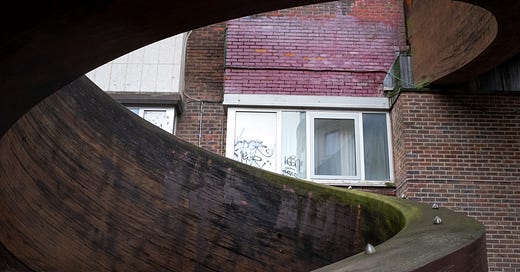


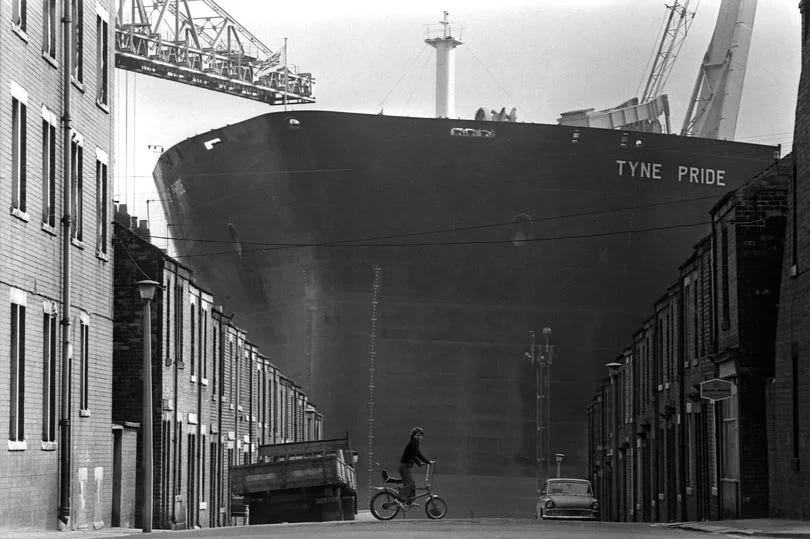

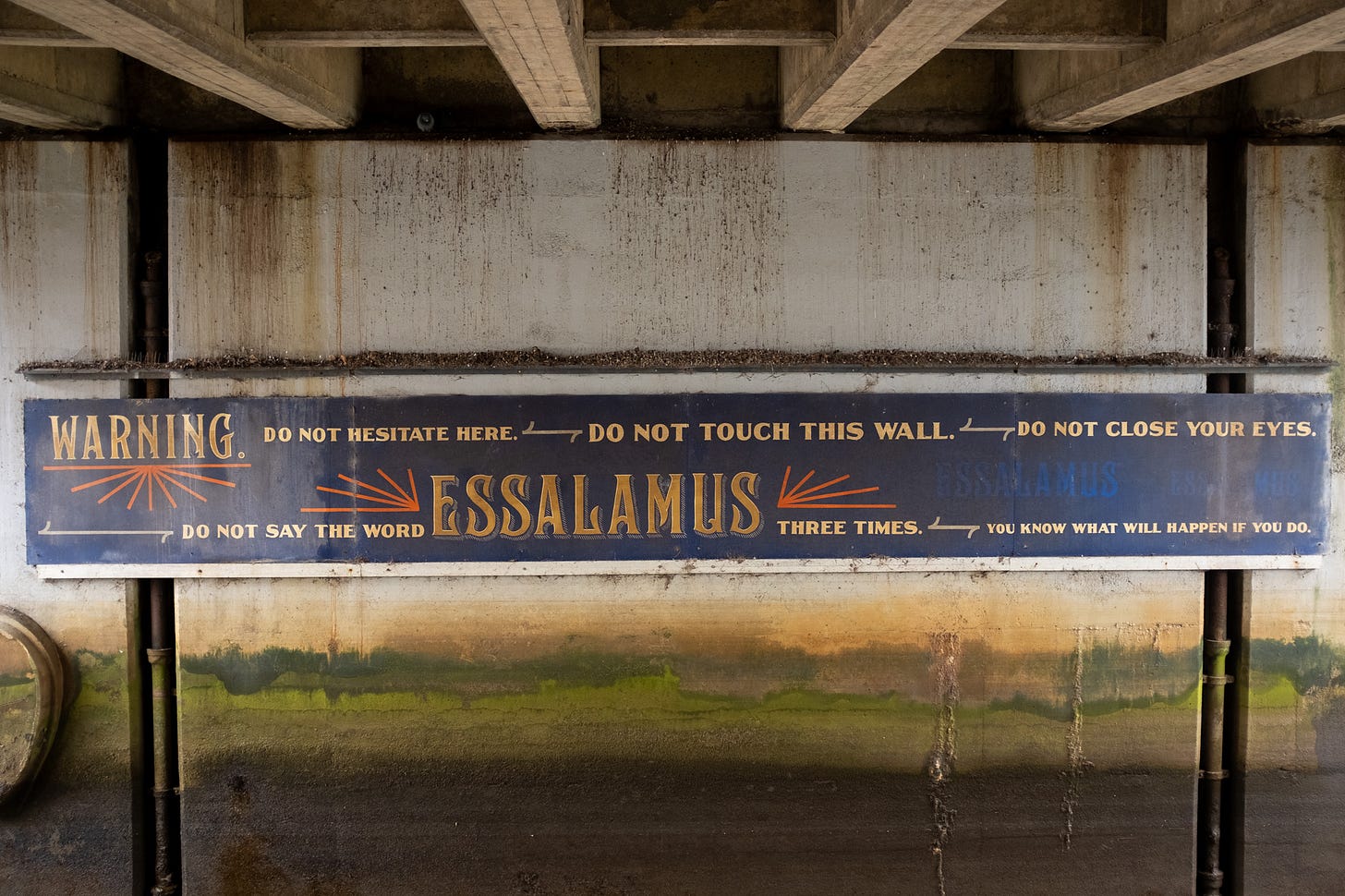
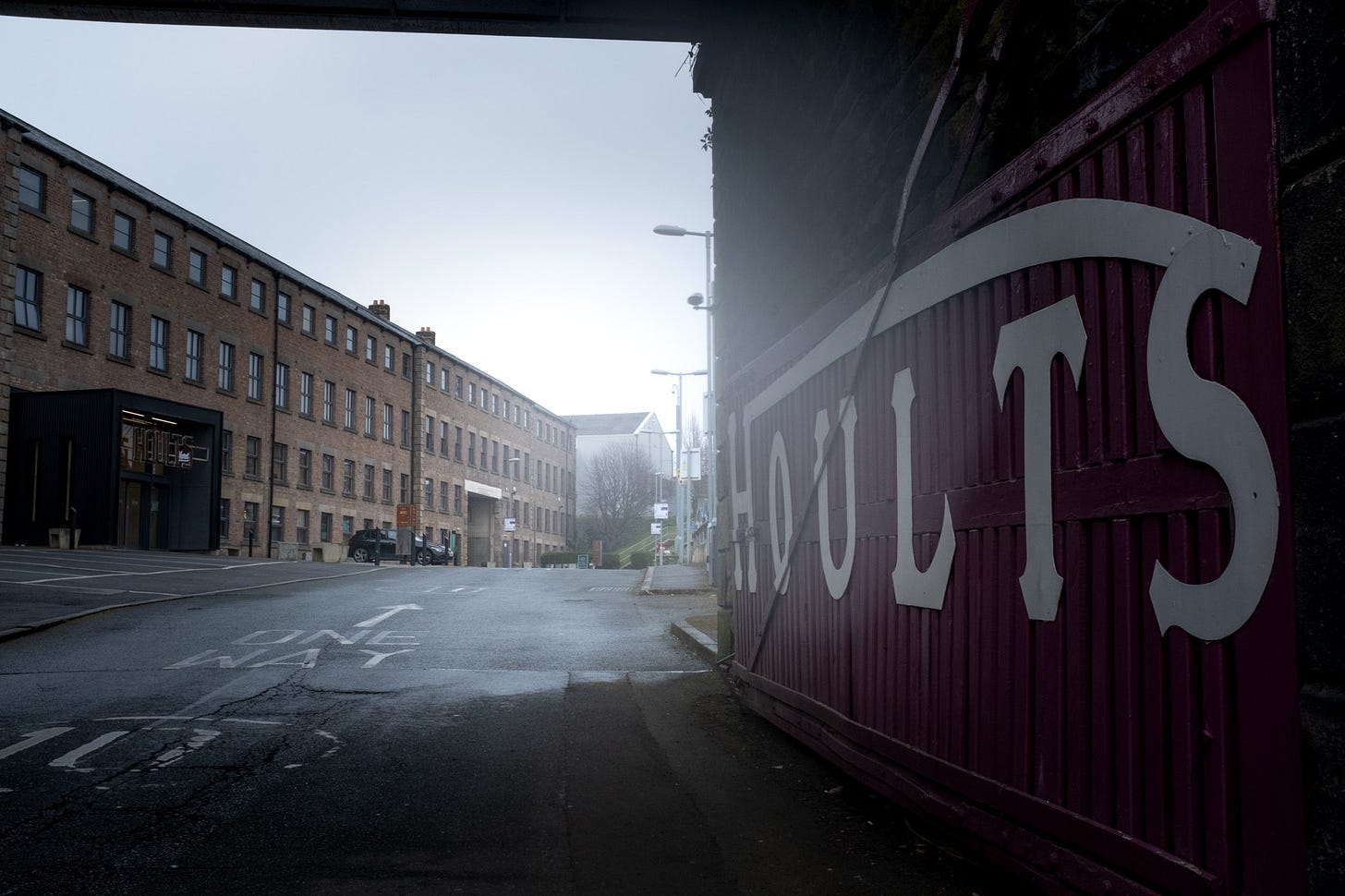
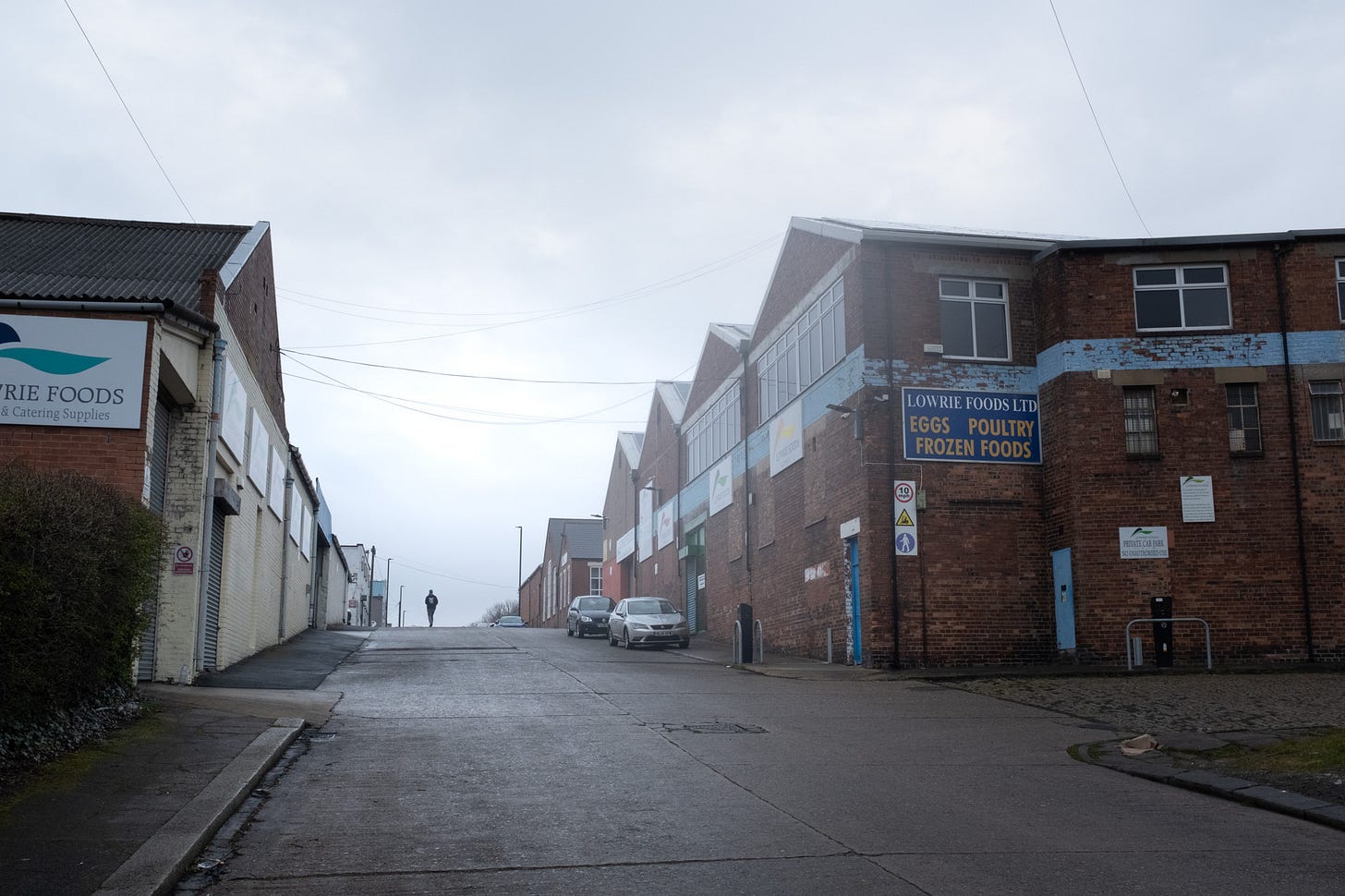
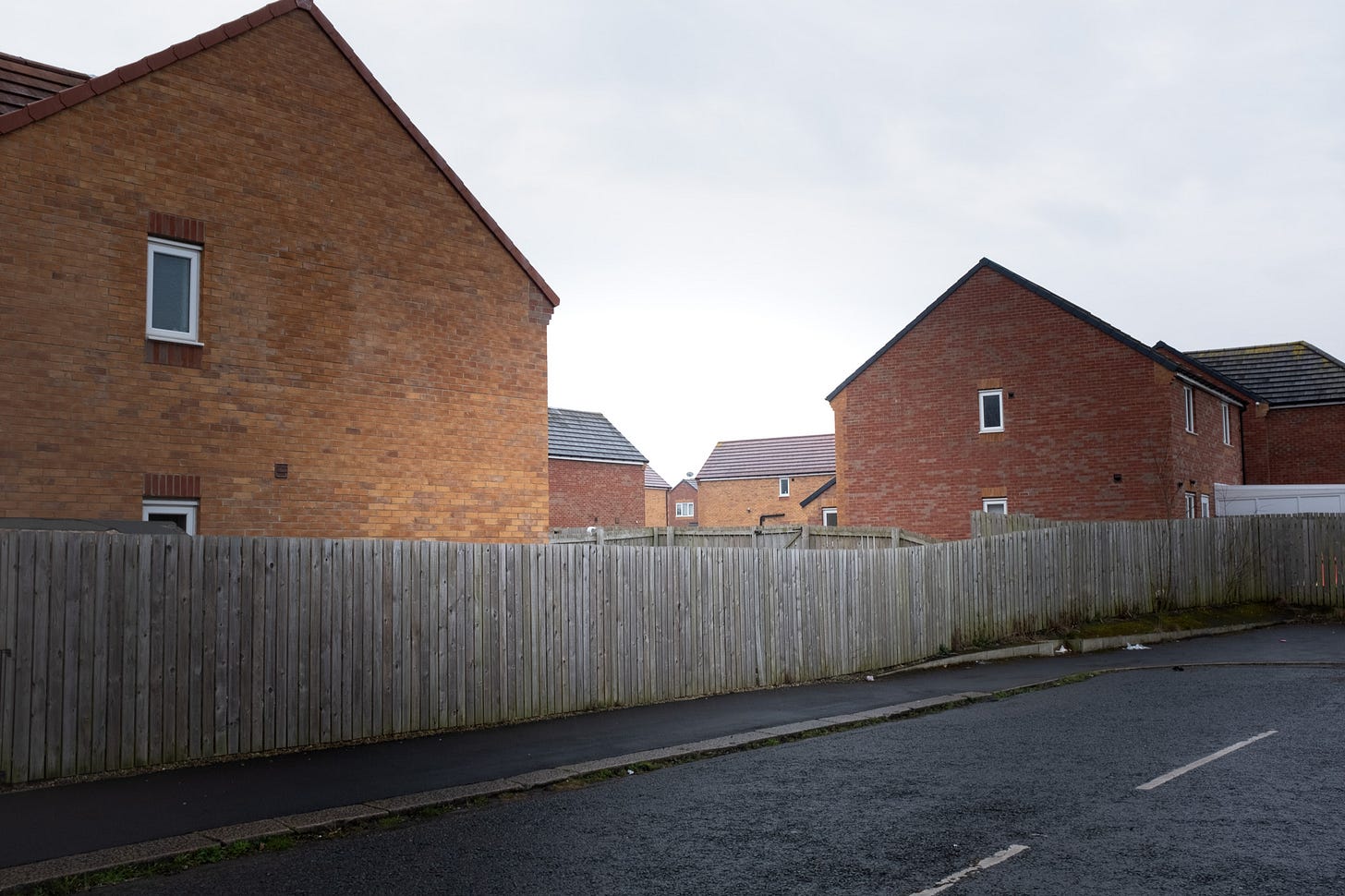
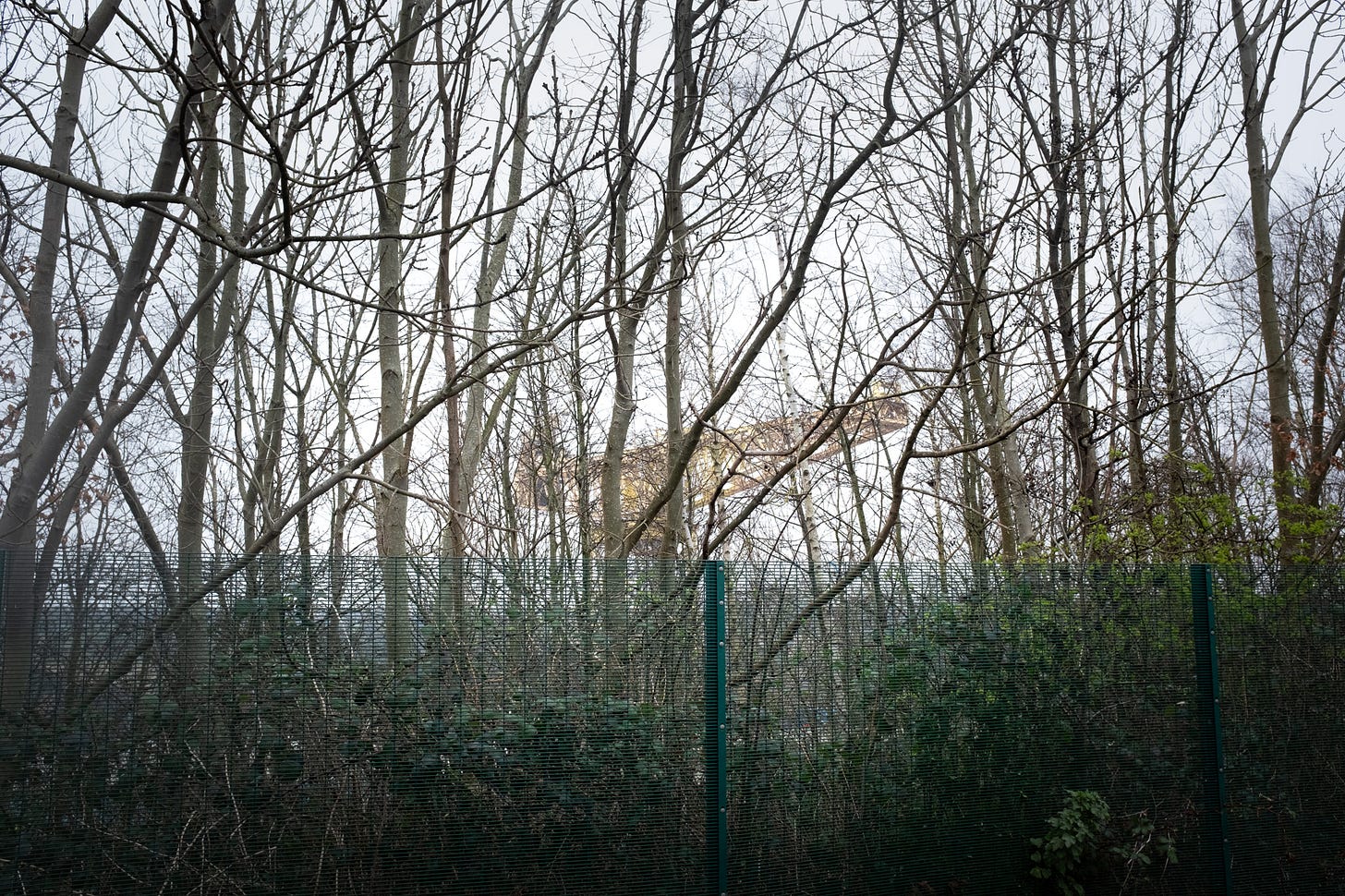
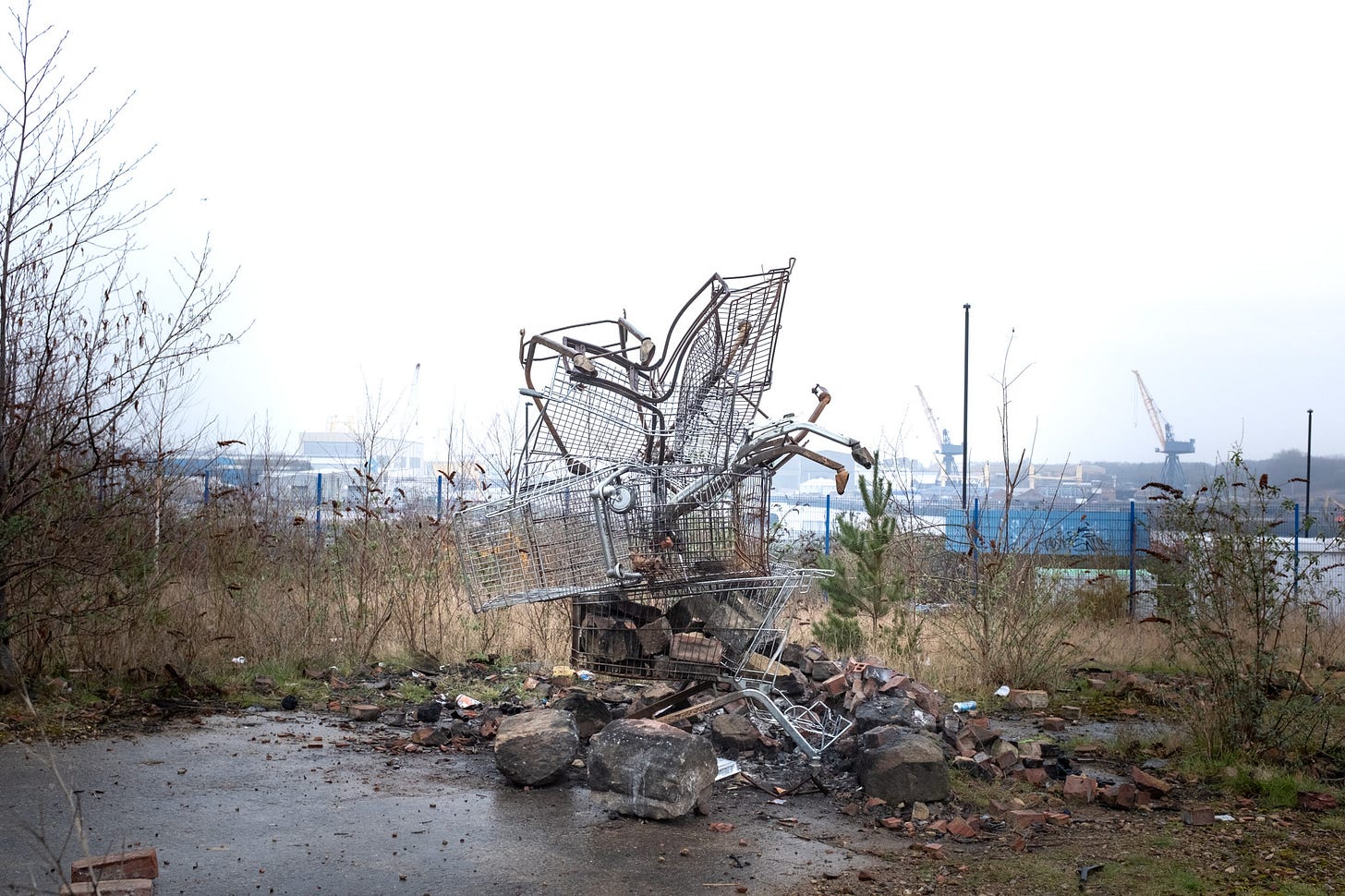
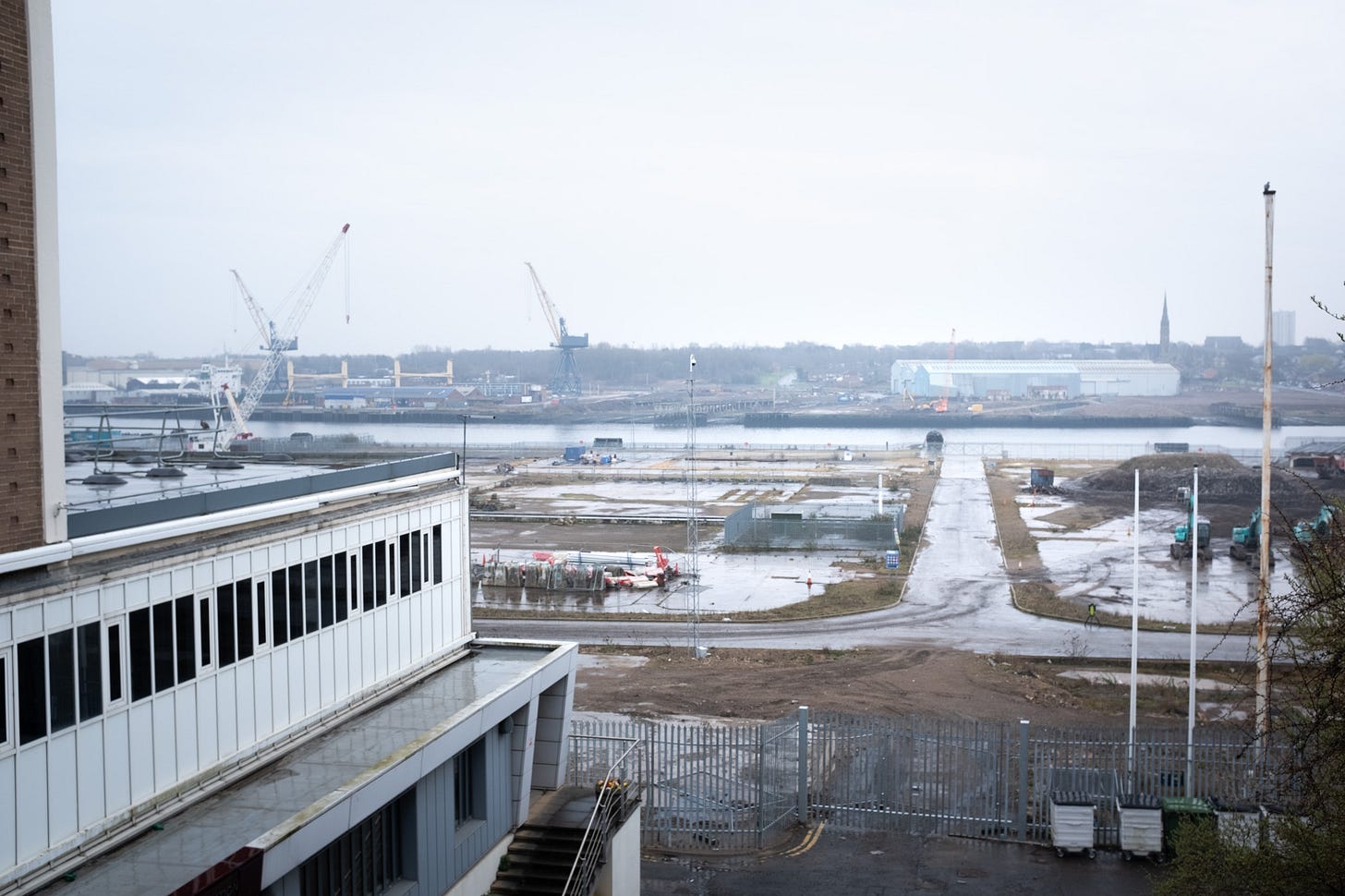
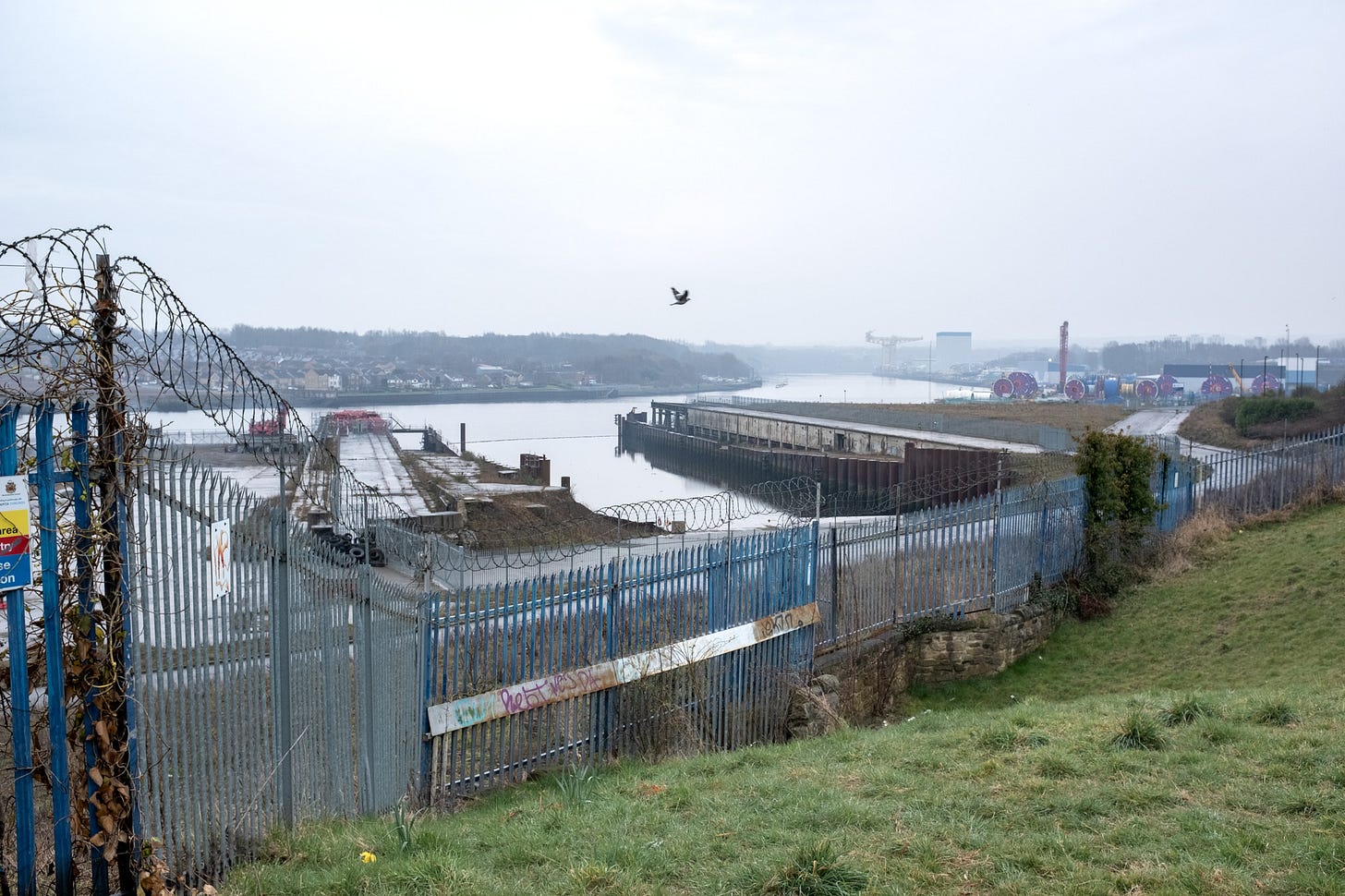
Beautiful.... well told. Armchair travel at its finest. And Killip, what can you possibly say? Did you know he went to Harvard because not a single UK university would have him? Thank you for the walk!